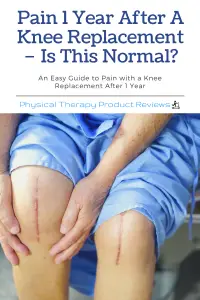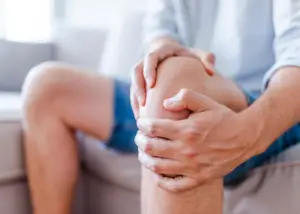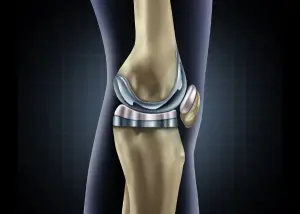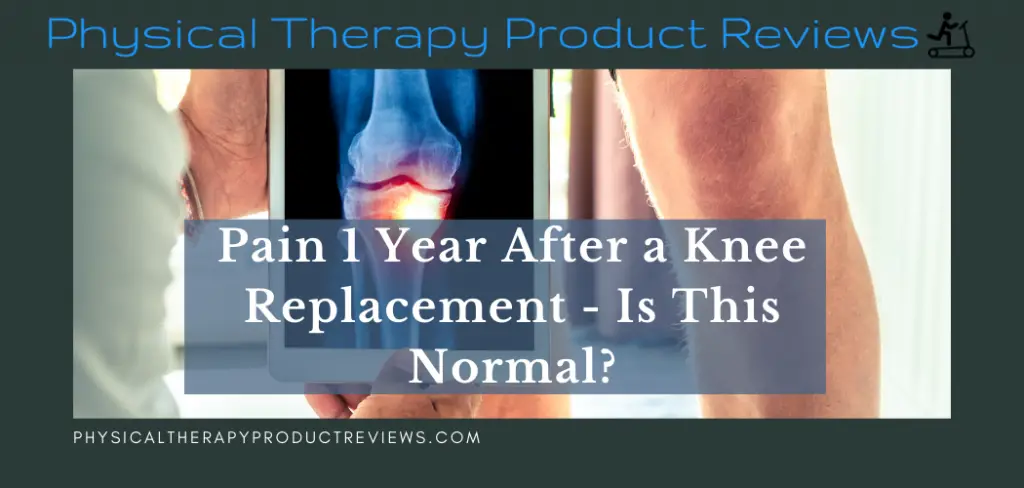 A knee replacement surgery can be a life-changing procedure! The vast majority of patients have a great reduction in pain and a significant improvement in quality of life. But is it normal to have pain after one-year post surgery?
A knee replacement surgery can be a life-changing procedure! The vast majority of patients have a great reduction in pain and a significant improvement in quality of life. But is it normal to have pain after one-year post surgery?
This article will guide you through the expected recovery timeline for a total knee replacement, how much pain is normal, and when it’s time to see your surgeon again.
Expected Recovery After a Knee Replacement
It’s important to have realistic expectations of your recovery potential. Most patients have significant improvements after a knee replacement, though this doesn’t necessarily mean that everyone is entirely pain-free.
At One-Year Post Knee Replacement
Significant improvement in pain and function at one-year post surgery and beyond is expected! Data shows that half of the patients who undergo a knee replacement have no pain for years after surgery.
However, some patients (about 15-30%) do continue to experience various persistent pain or discomfort after their procedures. Most report mild pain, and a small minority report severe pain.
What affects postoperative pain scores?
- Depression may have a negative impact on surgical outcomes.
- A high level of other chronic pain in the body can influence pain reported after a knee replacement.
- Obesity, tobacco use, and poor mental health status can each have a negative impact on outcomes.
- Improving balance can positively influence postoperative function, pain, and quality of life.
- Attendance of supervised physical therapy rehabilitation positively impacts outcomes.

What does NOT affect postoperative pain scores?
- The amount of pain reported before surgery does not typically correlate with the amount of pain reported after surgery.
Remember to avoid:
- High impact activities (like jogging), unless advised otherwise by your surgeon.
- High fall-risk activities like skateboarding or gymnastics.
Causes of Pain After a Knee Replacement
At one year post-surgery, you should no longer feel the acuteness of your procedure. Your knee should not be experiencing significant swelling or severe pain. Some discomfort may be expected and easily addressed by your physical therapist.
Common causes of pain at this point include the following:
- Kneeling on your affected knee.
- Weakness of the muscles surrounding the knee.
- Poor balance.
Uncommon causes of pain after a knee replacement include:
- Loosening of the implant components: though this can be common at about 15 years post-op, it should not be occurring at 1-year post-op.
- Malalignment of the implant: could be from the procedure or after a fall.
- Fracture: possible after a fall, especially in patients over 70.
- Infections: occurs in less than 1% of patients. Symptoms include swelling, redness to the joint, increased pain, and fever.

When to Consult with your Surgeon
Though rare, it isn’t unheard of for the uncommon causes listed above to be the culprit of pain.
If you are experiencing any of the symptoms below, it would be wise to consult with your surgeon:
- Swelling or redness around your knee
- Inflammation to your knee or calf
- Difficulty moving the knee
- New onset of sharp pain
- Difficulty with daily activities
- Increased knee pain with accompanied fever
When revisions must be completed for a total knee replacement, the success rate remains high. The rate of total knee replacement revisions at the 10-year mark is around 6%. The need for a revision before the 10-year mark is quite rare as implants are expected to last 15-20 years.

Have an honest conversation with your surgeon about your post-operative expectations and heed the guidance of your physical therapist.
FAQ Regarding Knee Replacements
Can Knee Replacements Fail?
Yes, a total knee replacement prosthesis can fail but the incident is really quite low.
The American Association of Hip and Knee Surgeons estimate the failure rate is 0.5 to 1 percent each year.
How Long Do Knee Replacements Last?
The association estimate that 90 to 95 percent of knee replacements will last 10 years and 80 to 85 percent will last at least 20 years.
As surgical techniques and surgical materials improve knee replacements will last longer.
Will a Knee Replacement Fix Arthritis?
Yes, a total knee replacement will fix any arthritis that is in the knee joint. In a total knee replacement surgery they resurface the ends of the bone and take out the arthritic pieces therein creating a new joint.
Is a Knee Replacement Painful?
A knee replacement is painful but if you stay on a pain regiment and work through your physical therapy exercises, the pain dissipates within a few weeks to months.
There are quite a few tips to help with pain after a total knee replacement that can help you manage the pain. The first 1-2 weeks are the worst but it improves from there.
What are Knee Replacements Made of?
Total knee replacement prosthesis are made of titanium or cobalt alloys. The plastic used in a total knee replacement is made of polyethylene.
Some implants do use ceramic and metal mixtures.

Conclusion
Total knee replacement surgery has a high satisfaction rate and a significant likelihood of success. Know that the recovery from this surgery is a journey to be continued – keep working on your physical therapy exercises and remain active for the best possible outcomes.
Pain at one year post-surgery isn’t uncommon, but if you are experiencing concerning symptoms, be sure to consult with your surgeon!
Works Cited:
Jette DU, et al. Physical therapist management of total knee arthroplasty. Physical Therapy. 2020; 100(9): 1603-1631. https://www.ncbi.nlm.nih.gov/pmc/articles/PMC7462050/
Momoli A, Giaretta S, Modena M, Micheloni GM. The painful knee after total knee arthroplasty: evaluation and management. Acta Biomedica. 2017; 88(2): 60-67. https://www.ncbi.nlm.nih.gov/pmc/articles/PMC6179006/
Pabinger C, Berghold A, Boehler N, Labek G. Revision rates after knee replacement. Cumulative results from worldwide clinical studies versus joint registers. Osteoarthritis and Cartilage. 2013; 21(2): 263-268. https://www.sciencedirect.com/science/article/pii/S1063458412010278
Philips JRA, Hopwood B, Arthur C, Stroud R, Toms AD. The natural history of pain and neuropathic pain after knee replacement. The Bone & Joint Journal. 2014; 96-B(9):1227-33. https://online.boneandjoint.org.uk/doi/full/10.1302/0301-620X.96B9.33756
Schwartz I, Kandel L, Sajina A, Litinezki D, Herman A, Mattan Y. Balance is an important predictive factor for quality of life and function after primary total knee replacement. The Journal of Bone and Joint Surgery. 2012; 94-B(6). https://online.boneandjoint.org.uk/doi/full/10.1302/0301-620X.94B6.27874
Other Great Rehab Related Articles
How to Stay Active After Cervical Fractures: Expert Tips and Advice
Dealing with Painful Stairs After Ankle Replacement Surgery
Walking After a Total Ankle Replacement: Tips for a Successful Recovery
Exercises While Non-Weight Bearing After Ankle Replacement: Elevation, AROM, Leg Raises, and More
Ankle Pain with Stairs: Causes and Home Treatment Options
5 Common Mistakes You’re Making After an Ankle Sprain
Disclaimer: The information provided in this post is for educational purposes only. This is not a substitute for a medical appointment. Please refer to your physician before starting any exercise program.






